Art
Advertising
- Advertising
- Tin (Cassiterite) Distribution: Mediterranean Bronze Age
- Archaeological Sites of the Aegean Minoans
- Extent of Santorini Eruption's Tsunami Inundation of Minoan Crete
- End of Minoan Linear A Writing and LM IB Fire Destruction of Crete
-
The Cause of the End of the Bronze Age
with the Scientific Method -
Nature Geoscience Journal and
Late Minoan IB Destruction Event - Prehistoric Star Navigation, Eastern Mediterranean Ethnocentric Bias, and the "Cabal of Certainty"
- Theoretical Bronze Age Minoan Heliographic Aegean Network Validated by 92.15 Mile (148.3 Km) Mirror Sunlight Flashes
- The Validation of a Bronze Age Minoan Heliographic Aegean Network in Southern California
- Tsunami Generation from the Titanic Bronze Age Minoan Eruption of the Santorini Marine Volcano
- The Cento Camerelle Mines of Tuscany: A Major Bronze Age Source of Tin
- No Men or Sails Required: Successful Prehistoric Sea Travel
- Minoan Downfall and Volcanology's Black Hole of Unknowns
- Homer and Navigating by the Stars in Prehistory
- Primacy of Human Powered Rowing in Copper Age and Minoan Shipping
- Minoan Invention of the True Dome and Arch Prehistoric Mediterranean Catenary Architecture
- "Sinking Atlantis" Tsunami Myth Debunked
- Minoan Tholos Structural Mechanics and the Garlo Well Temple
- Minoan Web of Mirrors and Scripts
- Santorini Eruption and LM IB Destruction
- Minoan Catastrophe: Pyroclastic Surge Theory
- Early Minoan Colonization of Spain
- Origin of the Sea Peoples
- Minoan Ship Construction
- Minoan Maritime Navigation
- Ringed Islands of Thera, Santorini, Greece
- Minoan Scientific Tradition
GIS Google Earth
Publications
Publications
Official Art Gallery
A Collection of 20 Paintings each with over 70 Art Products
Thera was basically two separate islands composed of a roughly circular inner one that was almost completely enclosed by an outer island that ringed around it. The mostly flat plain of the inner island ranged from six to eight kilometers wide. The outer ringing island was fourteen kilometers from east to west and eighteen kilometers from north to south. The closest they came to touching each other was about four or five hundred meters. There was a single three kilometer opening in the southwest of the outer island that allowed access to its interior from the open sea. The two islands were the remnants of an ancient marine volcanic caldera. Any ships anchored inside the outer island were protected from all the winds and rough seas beyond it. It was the finest natural harbor in the whole of the Aegean.

Minoan Miniature Frieze Admirals Flotilla Restoration Fresco
Depiction of the Ringed Islands of Thera
Late Bronze Age (LBA)
Neo-Palatial Late Minoan I Period
West House, Room 5, South Wall
Akrotiri, Santorini (Thera), Greece
Depiction of the Ringed Islands of Thera
Late Bronze Age (LBA)
Neo-Palatial Late Minoan I Period
West House, Room 5, South Wall
Akrotiri, Santorini (Thera), Greece
Thera was the largest Minoan commercial trading and manufacturing center outside of Knossos on Crete. The dockyards and warehouses of the port city of over forty thousand people were located on the western side of the fifty square kilometer inner island. The huge palace complex was about two and a half kilometers to the east of the port near the center of the island. It stood proudly above the town on a low wide human-sculpted promontory that dominated the fertile plains of the island.
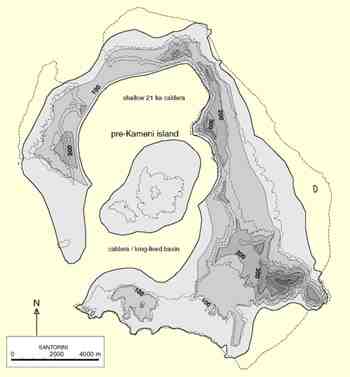
Geological Reconstruction of Pre-Minoan Eruption Thera
Druitt and Francaviglia, 1992
Santorini (Thera), Greece
Courtesy: Tom Pfeiffer -
Druitt and Francaviglia, 1992
Santorini (Thera), Greece
Courtesy: Tom Pfeiffer -
Thera was an important naval base for dealing with the persistent problem of piracy especially in the northern seas. It was strategically located in the south central Aegean within easy sailing distance of the Myceneans in the west, the Hittites in the east, and the Trojans and Thracians in the north with a direct connection to Knossos in the south. Much of the trade in the entire area, especially from the north, was shipped there for distribution to Knossos and far beyond. Products from Thera found there way to the Egyptians and Kushites in the south, and the Canaanites, Hittites, and Assyrians in the east.
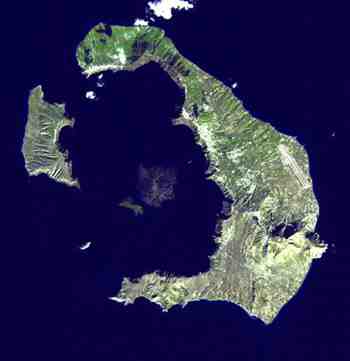
Present Day Thera
Santorini, Greece.
Santorini, Greece.
There were several towns and villages on the islands. The largest of these was the port city of Thera on the inner island. The biggest town on the outer island was Therasia in the northwest. There was a causeway and bridge joining it to the inner island. Therasia was about twice the size of Akrotiri in the south. Everyone else on the outer island had to take a short boat or ferry ride to access the inner one.
With only about one hundred and sixty square kilometers of land, the two islands couldn't possibly support the population of over one hundred and twenty thousand people living there. They were sustained by the influx of goods coming into its ports. Large quantities of barley and wheat from the Thracian grain shipments were stored in huge warehouses for year round processing and consumption.
With only about one hundred and sixty square kilometers of land, the two islands couldn't possibly support the population of over one hundred and twenty thousand people living there. They were sustained by the influx of goods coming into its ports. Large quantities of barley and wheat from the Thracian grain shipments were stored in huge warehouses for year round processing and consumption.

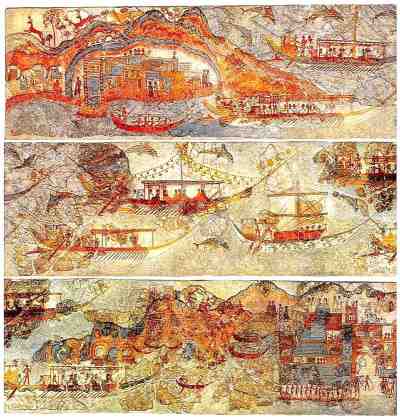
Minoan Miniature Frieze Admirals Flotilla Fresco
in Three Panels
Late Bronze Age (LBA)
Neo-Palatial Late Minoan I Period
The West House, Room 5, South Wall
3.90 x 0.43 meters
Akrotiri, Santorini (Thera), Greece.
in Three Panels
Late Bronze Age (LBA)
Neo-Palatial Late Minoan I Period
The West House, Room 5, South Wall
3.90 x 0.43 meters
Akrotiri, Santorini (Thera), Greece.
The climate was generally dry with almost no rain in the long hot summers, but the mild winters could be quite wet. The flat roofs of the buildings were slightly sloped to let the winter rains flow into terracotta drain pipes that filled their water cisterns for storage. The harvesting of water was mandatory for every masonry structure on the islands. In times of drought, water was imported like so many other things.
Wood for the numerous construction projects was mostly imported to save the sparse amounts of timber left on the island. The islands would have been totally denuded of trees long ago if the administration hadn't stepped in and sharply regulated it mainly for aesthetic reasons.
Wood for the numerous construction projects was mostly imported to save the sparse amounts of timber left on the island. The islands would have been totally denuded of trees long ago if the administration hadn't stepped in and sharply regulated it mainly for aesthetic reasons.

Akrotiri Archaeological Site
Akrotiri, Santorini (Thera), Greece
Akrotiri, Santorini (Thera), Greece
The Therans practiced a very high level of animal husbandry, and animal stock was imported in great quantities for food. The sheep, goats, pigs, and cattle were all domesticated and stabled or fenced outside the towns. Sheep and pigs were the staple meat diet of the people along with some cattle, but goats and deer were also consumed. The goats and cows provided the people with milk. Dried animal dung was used, as much as possible, to help fuel their braziers, kilns, and smelters. Much of their clothing was spun and weaved from wool, and their shoes were made from leather.
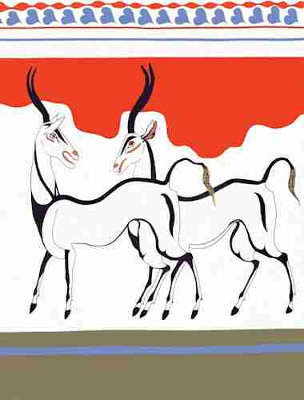
Minoan Antelope Restoration Fresco
Akrotiri, Santorini (Thera), Greece
Akrotiri, Santorini (Thera), Greece
The animal's skins, sinews, and bones were used as raw materials for an extraordinary number of things. Shell, bone, horn, and teeth were used to make tools, weapons, works of art, etc. Horn and sinews were used in making their bows, and oxhide covered their shields. Boar's tusks covered their helmets, and leather was used in their body armor.

Panaramic View from Imerovigli
Santorini (Thera), Greece.
Santorini (Thera), Greece.
Thera was the leading manufacturing center of textile products in the Aegean. There were several factories employing thousands of workers setup expressly to weave the sails of ships, clothing, and many other finished woolen and hemp products. Many of the villas and homes on the islands had their own weaving looms. Ships loaded with bales of wool filled the harbor to feed the factories. There was a significant sector of the workforce devoted to the production of fine jewelry and pottery for export. The profits of trade and production filled the treasury with gold. The people's standard of living was very high especially compared to the barbarian Myceneans in the west.
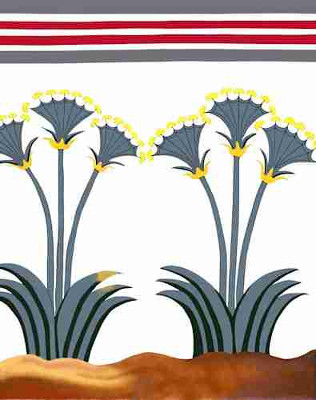
Minoan Sea Daffodils Lilies Restoration Fresco
Akrotiri, Santorini (Thera), Greece
Akrotiri, Santorini (Thera), Greece
Calusetne had never visited Thera in the springtime before. It looked even more beautiful than he remembered from his previous visits. His eyes were always drawn to the extraordinary red, black, yellow, and white layered rock pinnacles and sheer precipices of the walls of the outer island ringing the large plain of the inner one. The fertile fields of the islands were green expanses of mostly open pasture land. The grass and evergreen scrubs were dotted with patches of mainly oak trees mixed with groves of olive trees, junipers, and vineyards. Moving among them were large flocks of sheep and goats with smaller herds of cattle. Wild goats and deer lived in the hills of the outer island.
- Excerpt - "The Minoan Psychopath"
Bibliography:
Druitt, T. H. and Francaviglia, V. "Caldera formation on Santorini and the physiography of the islands in the late Bronze Age". Bulletin of Volcanology, Vol. 54, No. 6, p. 484-493. 1992.
Druitt, T. H. and Francaviglia, V. "Caldera formation on Santorini and the physiography of the islands in the late Bronze Age". Bulletin of Volcanology, Vol. 54, No. 6, p. 484-493. 1992.
Anthropologists have experimented with cooking in three-legged earthenware pots similar to the ones used by ancient Minoans. While it is easy to figure out how long to cook pork chops in the oven at 375, it is much more difficult to cook pork in an earthenware pot over hot coals.
2007
W. Sheppard Baird
Copyright © 2007, 2024 W. Sheppard Baird
All Rights Reserved
All Rights Reserved
-
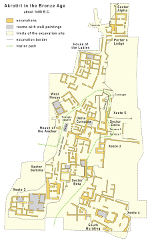
Map of Akrotiri Archaeological Site
Santorini (Thera), Greece
-
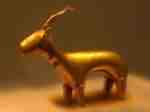
Minoan Golden Ibex
Akrotiri, Santorini (Thera), Greece
-

Spring Fresco West Wall
Swallows Scene
Akrotiri, Santorini (Thera), Greece
-

Minoan Stone Oven
Akrotiri, Santorini (Thera), Greece
-

Minoan Miniature Frieze
Admirals Flotilla Fresco
Shipping Scene Restoration
West House, Room 5, South Wall
Akrotiri, Santorini (Thera), Greece
-
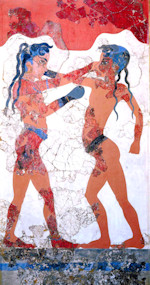
Minoan Boxing Boys Fresco
Akrotiri, Santorini (Thera), Greece
-
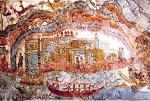
Minoan Miniature Frieze
Admirals Flotilla Fresco
Thera Scene
West House, Room 5, South Wall
Akrotiri, Santorini (Thera), Greece
-
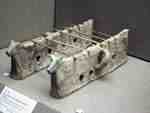
Minoan Terracotta Artifact
Akrotiri, Santorini (Thera), Greece
-
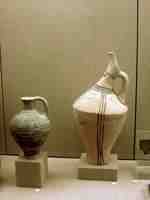
Minoan Terracotta Pottery
Akrotiri, Santorini (Thera), Greece
-
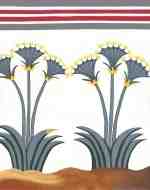
Minoan Sea Daffodils Lilies Restoration Fresco
Akrotiri, Santorini (Thera), Greece
-
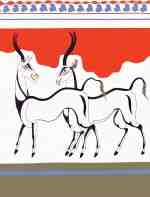
Minoan Antelope Restoration Fresco
Akrotiri, Santorini (Thera), Greece
-
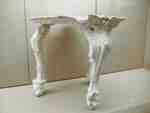
Minoan Volcanic Ash Cast Wooden Table
Akrotiri, Santorini (Thera), Greece
-
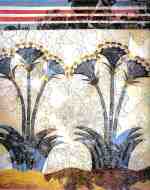
Minoan Sea Daffodils Lilies Fresco
Akrotiri, Santorini (Thera), Greece
-

Minoan Antelope Fresco
Akrotiri, Santorini (Thera), Greece
-
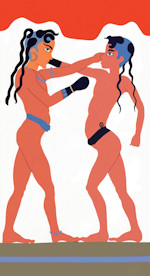
Minoan Boxing Boys Restoration Fresco
Akrotiri, Santorini (Thera), Greece
-
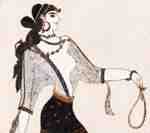
Minoan Adorants Fresco Closeup
Akrotiri, Santorini (Thera), Greece
-
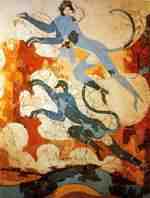
Minoan Blue Monkeys Fresco
Akrotiri, Santorini (Thera), Greece
-
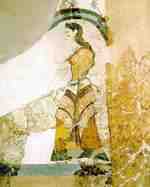
Minoan Lady with Papyri Fresco
Akrotiri, Santorini (Thera), Greece
-

Minoan River Scene Fresco
Akrotiri, Santorini (Thera), Greece
-

Minoan Saffron Gatherers Fresco
Akrotiri, Santorini (Thera), Greece
-
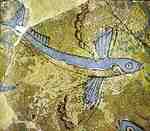
Minoan Flying Fish Fresco
Phylakopi, Milos, Greece
-
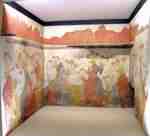
Minoan Spring Fresco
Akrotiri, Santorini (Thera), Greece
-
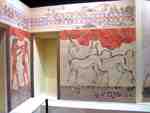
Minoan Fresco Art Exhibition
Akrotiri, Santorini (Thera), Greece
-
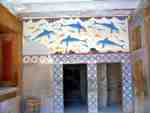
Minoan Dolphins Fresco Scene
Knossos, Crete, Greece